Knifemaking is a fascinating and complex craft. It requires a great deal of skill and knowledge, and even the slightest mistake can lead to disastrous results. If you’re thinking of starting a knifemaking business, it’s important to be fully aware of all the risks involved.
In this blog post, we will explore some of the key factors you need to consider before starting your own knifemaking business. From legal requirements to equipment recommendations, read on to learn everything you need to know about starting a knifemaking business.
Knifemaking is a craft that can be enjoyed by anyone with the proper equipment and a bit of patience. It’s not as difficult as it may seem, and there are many ways to make a living as a knifemaker.

Victorinox is one of the leading knife brands, and they make a wide variety of knives both for personal use and as part of their professional line. If you’re interested in starting your own knifemaking business, here are four things you need to know:
- Get the right tools. The first step in starting any craft is acquiring the necessary tools. For knifemaking, you will need an accurate cutting tool, such as a saw or blade grinder; woodworking tools, such as chisels and plane blades; grinding stones; leatherworking tools, such as punches and knives; and steel clamps. You can find most of these items online or at your local hardware store.
- Learn about anatomy. As you start learning about knifemaking, it’s important to know how the human body works. Study anatomy books to learn about different parts of the arms and hands. This knowledge will help you create more realistic designs for your knives and blades.
- Get organized. As with any new craft, it’s important to get organized from the start if you want to stick with it long-term. Keep track of all your knifemaking materials—from metal sheets to leather—and file them away in an orderly manner so that you can find them easily later on.
- Start with a design. Even if you don’t have any anatomical knowledge, it’s helpful to start with a design. This will give you a starting point for your knives and blades. Once you have a design in mind, you can start creating them using your cutting tool and woodworking tools.
Before starting a knifemaking business, be sure to consider all the risks involved. By following these tips, you can minimize those risks and get started on a successful career in this fascinating craft.

The Different Processes of Knifemaking
Knifemaking is an ancient craft that dates back to before the dawn of civilization. It has been passed down through generations and is still practiced today. There are a variety of different processes used to make knives, and each has its own benefits and drawbacks. This article will outline the different methods used to make knives, and their respective advantages and disadvantages.
There are three main types of knifemaking processes: manual, semi-automatic, and automated. Manual knifemaking is the oldest method and requires the most labor involved. Semi-automatic knifemaking uses motors to cut the steel, making it faster but less precise. Automated knifemaking uses machinery to automate many of the steps in the manufacturing process, making it more efficient but also costing more money upfront.

Conclusion
If you’re thinking about starting a knifemaking business, it’s important to know what kind of information is available and what you need to do in order to get started. In this article, we’ve outlined the steps you need to take in order to start your own knifemaking business and give you some valuable tips along the way. So, if you’re ready to take your craft to the next level, be sure to read on!

